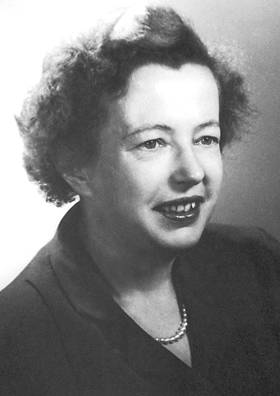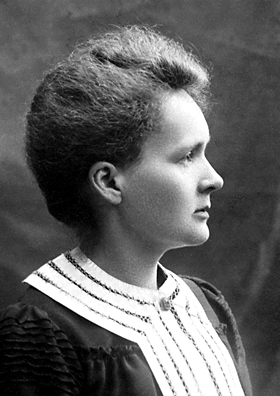Women in physics facts for kids
This article is all about amazing women who have made super important discoveries and contributions in the world of physics. Physics is the study of how the universe works, from tiny atoms to giant galaxies!
Contents
Women Who Won the Nobel Prize
- 1903 Marie Curie: Won for her work on radiation with her husband, Pierre Curie, and Henri Becquerel.
- 1963 Maria Goeppert Mayer: Won for her discoveries about the structure of the atom's center, called the nuclear shell structure.
- 2018 Donna Strickland: Won for creating a new way to make very powerful, super-short laser pulses.
- 2020 Andrea Ghez: Won for discovering a giant, super-heavy object at the center of our galaxy, the supermassive black hole.
Only four women have won the Nobel Prize in Physics since it started in 1901. Marie Curie was the first in 1903. She is the only woman to win two Nobel Prizes (her second was in Chemistry in 1911).
Maria Goeppert Mayer was the second woman to win in 1963. She helped us understand the inside of atoms. Donna Strickland was the third winner in 2018 for her work with powerful lasers. Andrea Ghez was the fourth in 2020. She helped find the supermassive black hole at the center of our galaxy.
A Timeline of Women in Physics
- 1668: Marguerite de la Sablière in France started a popular meeting place. Scientists met there to share ideas, and she studied physics with them.
The 18th Century
- 1732: Laura Bassi became the first female member of the Bologna Academy of Sciences in Italy. She earned her PhD and became the world's first female physics professor.
- 1738: Émilie du Châtelet from France was the first woman to publish a paper with the Paris Academy. It was about the nature of fire.
- 1740: Émilie du Châtelet published Institutions de Physique. This book explained the ideas behind Newtonian physics.
- 1751: Cristina Roccati from Italy earned her PhD from the University of Bologna at age 19.
- 1776: Laura Bassi became the first woman to lead a physics department at a university.
The 19th Century
- 1816: Sophie Germain from France won a prize from the Paris Academy of Sciences. Her work was on how things stretch and bend, called elasticity theory.
- 1840: Ada Lovelace from England published the first computer algorithm. This was a set of instructions for a machine.
- 1897: Isabelle Stone became the first woman to get a PhD in physics in the United States.
- 1898: Kirstine Meyer from Denmark won a gold medal from the Royal Danish Academy of Sciences and Letters.
- 1899: Edith Anne Stoney became a physics lecturer in London. She was the first female medical physicist. She later used x-ray machines in World War I.
- 1899: Marcia Keith and Isabelle Stone became founding members of the American Physical Society.
The 20th Century
1900s
- 1900: Marie Curie and Isabelle Stone were the only two women at the first International Congress of Physics in Paris, France.
- 1903: Marie Curie was the first woman to win a Nobel Prize in Physics. She won for her work on radiation with her husband and Henri Becquerel.
- 1906: Hertha Ayrton from England was the first woman to receive the Hughes Medal. She won for her research on electric arcs.
- 1909: Kristine Meyer became the first Danish woman to get a doctorate in natural sciences.
1910s
- 1911: Marie Curie won her second Nobel Prize, this time in Chemistry. She discovered the elements radium and polonium.
- 1918: Emmy Noether created Noether's theorem. This theorem explains the link between symmetry and conservation laws in physics.
1920s
- 1925: Cecilia Payne-Gaposchkin showed that hydrogen is the most common element in stars. This means it's the most common element in the universe!
- 1926: Katharine Burr Blodgett was the first woman to earn a Ph.D. in physics from the University of Cambridge.
- 1926: Lucy Mensing was the first to use Quantum Mechanics to study molecules.
1930s
- 1936: Inge Lehmann from Denmark discovered that Earth has a solid inner core. This core is different from its liquid outer core.
- 1937: Marietta Blau and Hertha Wambacher won the Lieben Prize. They studied cosmic rays using special photographic plates.
- 1939: Lise Meitner helped discover nuclear fission. This is how uranium atoms split when they absorb a neutron.
- 1939: Marguerite Perey from France discovered the element francium.
1940s
- 1941: Ruby Payne-Scott became Australia's first female radio astronomer.
- 1945: Six American women, including Frances Spence and Betty Holberton, programmed the first electronic computer, ENIAC. They were among the world's first computer programmers.
- 1947: Berta Karlik won the Haitinger Prize for discovering the element Astatine.
- 1949: Rosemary Brown (later Fowler) discovered the k-meson particle. This discovery helped lead to the Standard Model of particle physics.
1950s
- 1952: Rosalind Franklin's lab took Photograph 51. This X-ray image of DNA was key to finding its structure.
- 1956: Chien-Shiung Wu showed that a basic rule of physics, called parity, could be broken in weak interactions. This was a big discovery in nuclear physics.
1960s
- 1960: Rosalyn Yalow won the Nobel Prize in Physiology or Medicine. She developed a way to measure tiny amounts of hormones in the body.
- 1962: Marguerite Perey became the first woman elected to the Académie des Sciences.
- 1963: Maria Goeppert Mayer was the first American woman to win the Nobel Prize in Physics. She won for her work on the nuclear shell structure.
- 1964: Chien-Shiung Wu spoke at MIT about gender discrimination.
- 1967: Jocelyn Bell Burnell helped discover the first pulsars. These are rapidly spinning stars that send out radio waves.
1970s
- 1971: Mina Rees became the first woman president of the American Association for the Advancement of Science (AAAS).
- 1972: Willie Hobbs Moore became the first African-American woman to get a Ph.D. in physics.
- 1972: Sandra Faber was the first woman to join the Lick Observatory staff.
- 1973: Anna Coble became the first African-American woman to get a PhD in biophysics.
- 1978: Chien-Shiung Wu won the Wolf Prize in Physics for her work on the Standard Model.
1980s
- 1980: Deborah Ajakaiye became the first female physics professor in West Africa.
- 1985: Mildred Dresselhaus was appointed the first female Institute Professor at MIT.
- 1986: The Maria Goeppert Mayer Award was created to honor young female physicists.
- 1986: Jean M. Bennett became the first woman president of The Optical Society.
1990s
- 1995: Reva Williams worked out how the Penrose process works for rotating black holes.
- 2000: Mildred Dresselhaus became the director of the Office of Science for the United States Department of Energy.
- 2000: Kathy Vivas discovered about 100 new RR Lyrae stars. This helped us understand our Milky Way galaxy.
The 21st Century
2000s
- 2001: Lene Hau managed to completely stop a beam of light.
- 2003: Claudia Alexander oversaw the end of Project Galileo, a mission to Jupiter.
- 2003: Deborah S. Jin and her team were the first to condense pairs of fermionic atoms.
- 2007: Ibtesam Badhrees was the first Saudi Arabian woman to join CERN.
2010s
- 2011: Chung-Pei Ma led a team that found two of the biggest black holes ever seen.
- 2013: Nashwa Eassa started an organization called Sudanese Women in Sciences.
- 2014: Shirley Anne Jackson received the National Medal of Science. She was the first African-American woman to get a PhD from MIT.
- 2015: Rabia Salihu Sa'id won the Elsevier Foundation Award for Women Scientists in Developing Countries.
- 2016: Fabiola Gianotti became the first woman Director-General of CERN.
- 2018: Hiranya Peiris, Joanna Dunkley, and Licia Verde won the Breakthrough Prize in Fundamental Physics. They made detailed maps of the early universe.
- 2018: Jocelyn Bell Burnell received a special Breakthrough Prize in Fundamental Physics. She donated the $3 million prize to create scholarships for women and minorities in physics.
- 2018: Donna Strickland won the Nobel Prize in Physics for her laser inventions.
- 2018: For the first time, women won both the Nobel Prize in Chemistry and the Nobel Prize in Physics in the same year.
- 2019: Karen Uhlenbeck was the first woman to win the Abel Prize. This award is for her important work in mathematics and physics.
2020s
- 2020: Andrea M. Ghez won the Nobel Prize in Physics for finding a supermassive object at our galaxy's center.
- 2022: Anne L’Huillier won the Wolf Prize in Physics. She was recognized for her work with super-fast lasers.
See also

All content from Kiddle encyclopedia articles (including the article images and facts) can be freely used under Attribution-ShareAlike license, unless stated otherwise. Cite this article:
Women in physics Facts for Kids. Kiddle Encyclopedia.


